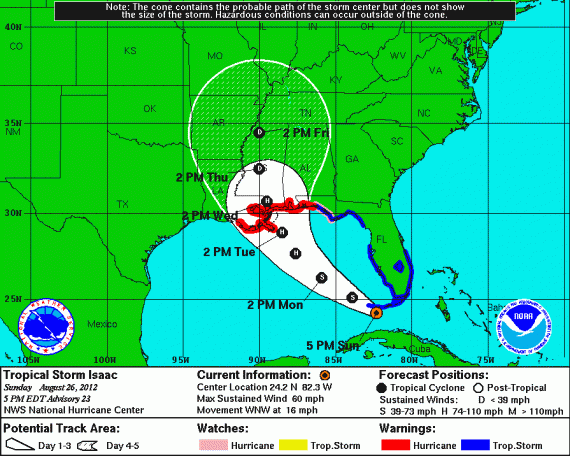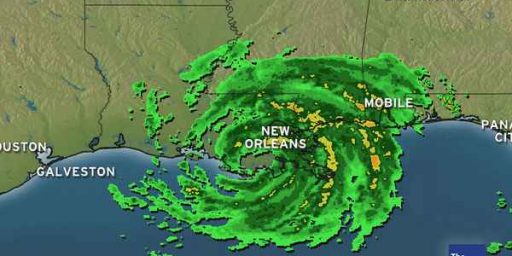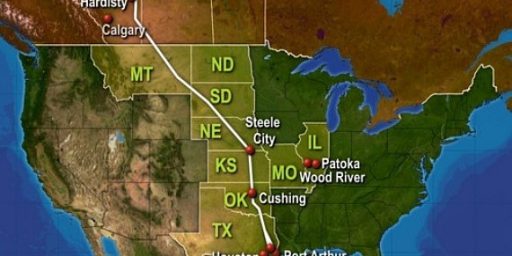Isaac Could Rival Hurricane Katrina
Though still just a Tropical Storm, Isaac has the potential to be as dangerous as Hurricane Katrina.
With the threat to Tampa and the Republican National Convention largely out of the picture, attention is now being turned to a bigger question; whether Tropical Storm Isaac could end up being a far more destructive storm than anyone anticipated just a few days ago:
On August 24th, we warned on Forbes that Tropical Storm Isaac could pose a threat to energy markets and even rival Hurricane Katrina in its destructive power (Could Tropical Storm Isaac Turn Into Another Katrina?). While the computer models are still showing a substantial spread in solutions, it appears more likely that Isaac will make landfall somewhere near the Louisiana, Mississippi Gulf Coast. This track will provide the storm more time to intensify over the very warm water of the Gulf of Mexico.
The entire Gulf Coast from Lake Charles, LA to Panama City, FL should be aware of the latest forecast model guidance. The reason for this large spread is because the computer models are split between whether a trough will capture Isaac or not. As of 8AM Sunday morning, it appears Isaac will not be captured and as a result, a more westward track is most likely.
Hurricane Katrina made landfall near New Orleans on Aug 29, 2005. It is estimated that the total economic impact in Louisiana and Mississippi exceeded $110 billion, earning the title of the most expensive hurricane ever in US history.
As Katrina moved through the heart of the Gulf of Mexico offshore oil and natural gas production area, it negatively impacted nearly 20% of US oil production. Hurricane Katrina, followed by Hurricane Rita in September, destroyed 113 offshore oil and gas platforms and damaged 457 oil and gas pipelines. Oil, gasoline, and natural gas futures prices on the NYMEX soared as damage assessments were reported.
The hurricane damage inflicted by Katrina caused oil prices to increase from the mid-$60s per barrel to over $70/bbl and gasoline prices at the pump rocketed to near $5 a gallon in some areas of the US. The US government released oil from its stockpile in the Strategic Petroleum Reserves (SPR) to offset price rises. In the natural gas market, prices were trading in the $9 to $10/MMBtu range at the time, but spiked to over $15/MMBtu as the full extent of the damage became apparent.
Additionally, the Louisiana Offshore Oil Port (LOOP) was closed on August 27, 2005, reducing production by over 400,000 barrels per day. LOOP handles 13% of the nation’s foreign oil, about 1.2 million barrels a day, and connects by pipeline to 50% of the U.S. refining capability. The port was undamaged by the storm and resumed operation within hours of electricity coming back online.
Gulf of Mexico oil production was reduced by about 1.4 million barrels per day as a result of Hurricane Katrina, equivalent to about 91% of daily Gulf of Mexico oil production. Additionally, over 8 billion cubic feet (Bcf) per day of natural gas production was shut in, equivalent to 83% of daily Gulf of Mexico natural gas production.
Seven years later as what will be Hurricane Isaac bears down on the Gulf Coast, the Gulf of Mexico currently accounts for about 23% of oil production and 7% of natural gas output according to the US Department of Energy. Furthermore, roughly 30% of natural gas processing plant capacity and 44% of US refining capacity is located along the US Gulf Coast.
According to the Bureau of Ocean Energy Management (BOEMRE), 8.6% of the Gulf’s daily oil output and 1.6% of daily natural gas production was shut down as a result of Isaac approaching the Gulf of Mexico. Closing prices as of Friday, Aug 24, 2012 of NYMEX October WTI futures settled at $96.15/bbl, while September natural gas settled at $2.70/MMBtu.
One thing this potentially portends is a sudden intense spike in energy prices like the one that we experienced in 2005 when Katrina hit, along with possible supply disruptions for those parts of the country most dependent upon gasoline supplies from the Gulf Coast. In that regard, I am reminded of the time during Katrina’s assault on the Gulf Coast when I drove up to the local gas station I frequented at the time on the way home from work only to learn that they literally had no gas to sell because their supply truck had not arrived that day. It was something of a surreal experience, because the reliability of gas coming out of the pump is something we had come to rely upon as much as the reliability of water coming out of the kitchen sink. Within days, local gas prices skyrocketed thanks to high demand and low supply, and while they dropped fairly quickly after supply lines had been re-established, I can’t say I’ll ever forget the moment when there was no gas coming out of the pump.
But, of course, there are larger concerns than just the supply of oil and gasoline. Everyone remembers Hurricane Katrina, and the people in Southern Louisiana aren’t wasting any time. Even before any state officials had made a statement, the President of Jefferson Parish, which encompasses most of the suburban New Orleans area, declared a State of Emergency. Louisiana Governor Bobby Jindal extended the State of Emergency declaration to cover all of Southern Louisiana, and New Orleans Mayor Mitch Landrieu made a similar declaration for his city. At the same time, though, Landrieu oddly didn’t call on city residents to evacuate, something which Brendan Loy, who was the first person to note that Louisiana residents needed to get out of town in advance of Katrina, criticizes heavily:
In a bizarrely low-key press conference that seemed more focused on calming residents’ “anxiety” and vaguely telling them to “be prepared” (and then making of a series of mundane announcements about municipal matters like trash collection and parking restrictions) than on advising them to take specific, concrete steps commensurate to the risk of a possibly major hurricane potentially making a direct hit on America’s most hurricane-vulnerable city starting in about 48 hours, New Orleans Mayor Mitch Landrieu did his best Ray Nagin impression Sunday, announcing a no-evacuation, “shelter in place” plan that suggests a stunning level of confidence that a worst-case scenario won’thappen, at a time when it remains, meteorologically speaking, very much in play.
The possibility that residents would be “sheltering in place” in a “place” the could, in the worst-case scenario, be swallowed up by the Gulf of Mexico, was not mentioned.
Mayor Landrieu said he did not anticipate announcing any revisions to the plan — such as a decision to order evacuations, a possibility he explicitly downplayed — until around noon tomorrow, by which time the onset of bad weather would be around 24 hours away. Despite reams of pre-Katrina literature indicating that it takes 48 to 72 hours to evacuate New Orleans in the event of a major hurricane threatening a direct hit, and despite the experience of 2005-s rushed and incomplete evacuation so flawed that it left 50,000 people to be rescued from rooftops and such by the Coast Guard, Mayor Landrieu apparently thinks 24 hours is enough time to make an evacuation work, if one is needed.
Okay then.
I want to be fair here. I’m neither a meteorologist nor a New Orleans official, planner or expert. Perhaps Landrieu is right, and I’m wrong. Perhaps New Orleans now has plans that will allow it to effectively evacuate in 24 hours’ time. My understanding has been that that’s basically impossible, but again, I’m concededly not an expert. It’s certainly true that, by midday tomorrow, we’ll have more and better information about Isaac’s projected path and intensity at landfall, both of which remain maddeningly difficult to pin down right now. So if it’s reasonably possible to wait until tomorrow morning to make the call, that would certainly be preferable. I’m just not so sure it’s reasonably possible. I thought the decision needed to be made today, despite the admittedly imperfect information and the very significant chance of a false alarm.
Even if an evacuation can reasonably be begun tomorrow if necessary, Mayor Landrieu certainly should have done more to prepare residents now for the possibility.
Much of this is, of course, a guessing game. The storm could bend east and end up leaving New Orleans with little more than a big rain storm. It could lose intensity, although that seems unlikely given the warm waters of the Gulf of Mexico. Given the current track, the fact that New Orleans would be on the western side of the storm could mean that it avoids most of the worst of the storm surge. But, those are all possibilities that the people who live there won’t know the answer to for at least 24 to 48 hours. By that time, evacuation would be a far more difficult task to accomplish, as we learned in 2005. It seems to me that this is one of those situations where “better safe than sorry” applies. If you evacuate and the storm turns out to be a dud, you’re out a couple days at home and a tank or so of gas. If you don’t, and the storm turns into something serious, you’ve got far bigger problems than a few charges on your credit card.
By the way, given the current track as shown above, I’d give that same advice to people on the Alabama and Mississippi Gulf Coasts.
Graphic via Brendan Loy’s Flickr Feed







Great. My son just moved to Baton Rouge. Not sure just exactly how this might affect him, but it won’t be good. On the other hand, we just might get some substantial rain fall up here.
Hmmmmmm…. Son? Rain? Son? Rain? Hard call…. Ok ok. Son…. unless my house burns down in a forest fire, at which point I will curse him…. And he won’t be surprised.
Uhh, Doug? Do you really think people are willing to face down forces of nature because it might cost them a tank of gas? One word: Looters.
@OzarkHillbilly:
Yes there are those elements. However, most of the people in the N.O. area are decent people. I have family there, actually. They bugged out days ahead of Katrina and, though I haven’t gotten word yet, I’m guessing the same game plan will be employed this time.
Good advice for the people with credit cards…..
@Herb:
Then hopefully Mayor Landrieu won’t be as stupid as Mayor Nagin and let the buses sit in a lot and get flooded by water.
Looters and the annoyance that once the hurricane has passed, no matter how minor, its often very difficult to get back home because law enforcement will treat you like a looter threat. I personally wouldn’t leave New Orleans for a Category 2 hurricane, if I still lived in Uptown; I might if I lived in lower areas though.
@OzarkHillbilly: We think alike. I see some potential welcoming rain coming up the Mississippie valley. It would be nice to be off water restrictions.
The lack of evac order can be problematic. Some people have to choose between leaving and losing their job. Others would end up without a re-entry pass for days or weeks since they aren’t handing those out yet. This doesn’t even consider the basically wards of the state (deep inner city welfare recipients) who have neither transportation nor means for escape.
Keep in mind, New Orleans was not seriously impacted by the surge of Katrina which went ashore just to the east up the LA/MS border. The problem came because the winds piled the lake water against the levees which failed due to past malfeasance with flood control money. The surge, dammed up by the Delta, couldn’t flow out so piled up till the storm passed and then flowed east across MS. The people at risk in MS and AL generally live south of 90 or close to a body of water that flows into the Gulf. Those are the ones seriously damaged by Katrina. With the angle Isaac is forecast to be on, New orleans may get both the wind piling up the lake water and a good portion of the storm surge.
Some interesting things we may see. First, again, the folly of depending on public transportation and the State for your welfare. Second, evacs usually cause people to run out of gas due to traffic, it will be interesting to see how anyone with an EV or hybrid makes out. The EV has no way of being re-energized in a hurry. Third, will they condemn some areas that are flooded out again denying building permits? Certainly should.
I was commenting over on WeatherNerd to someone defending the location of New Orleans. It occurs to me, that if we need New Orleans as a port, then we finally have a place where high speed rail makes sense. The port remains but the population isn’t allowed to live there, they use HSR to commute in for work then back out to high ground for sleeping and recreation.
Looks like Waveland MS is going to get again, Camille and Katrina both came ashore near there.
BTW, from the Times Picaynue,
So maybe he has learned something while walking the fine line between warning and scaring the people.
@Doug Mataconis:
Good point, but you’re going to need more than an unflooded parking lot of buses to evacuate a city.
@walt moffett:
Perhaps he has. His early afternoon press conference was oddly low-key, though
New Orleans will wait until a Category 3 hurricane is forecast. Link Right now its only forecast a Category 2 at most. The mayor can order people to leave, but most won’t, and he’ll blow the city’s credibility in the future.
@Doug Mataconis:
Gotta keep it low key, inciting panic could lead to more deaths and injuries. But like you, I want to see those buses moving, don’t want to hear the NOPD mounted unit has survived intact and still waiting for orders two days after the storm, nor that there has been a total loss of local leadership.
I honestly can’t imagine any of the people in charge would be dumb enough to twiddle their thumbs and not utilize resources like buses as happened with Katrina. My guess is most of them will choose to err on the side of caution rather than wait until it is too late to do anything.
I also can’t help but think Katrina is recent enough in resident’s memories that they will leave town even if there isn’t an evacuation order.
Hopefully the storm doesn’t cause as much damage as Katrina.
My oldest lives in the Uptown area of New Orleans. She and her roommate are ready to evacuate to Houston, but both of their offices said to be a work tomorrow morning. Both were told that there would be staff meetings to discuss how they will deal with the storm in the event it seems headed towards the city. My daughter is having a fit, wanting to leave for Houston first thing in the morning, getting out while the getting is good, before the interstates become parking lots. I told her to be patient and go fill her gas tank up tonight.
No one in New Orleans would have remembered Hurricane Katrina six months later if the levees hadn’t failed. If the levees have been beefed up to the point where failure is unlikely (a big if, to be sure), the risk from this latest storm isn’t too serious.
Unless Isaac can ramp up to a Cat 4 shortly, it won’t rival Katrina. That would require that it slow way, way down in it’s forward speed. While any hurricane, potential hurricane, or simple tropical storm should be taken seriously, there’s also a need to not hyperventilate and go overboard in the predictions.
I know this is secondary to possible property damage to houses and business, and loss if life, but major weather events put a strain on those who work hourly wages. I know that me and my coworkers are watching the storm, knowing that if we go a few days with the store closed, some of us may not be able to make bills. Yay, weather.
@Moderate Mom:
I wish your daughter well, Moderate Mom. It’s an uneasy feeling having your kids in harm’s way.
@Doug Mataconis:
Most people everywhere are decent people. Even around here where most people are Republicans 😉
@PD Shaw: Just checked the latest track and 2am Sat has it centered over my house, so I guess wherever it actually ends up, we will get a good drought busting rain.
Gonna call my son this morning and relieve whatever worries I may have. This is his first hurricane, but his girl friends family are long time residents so they know the dance.
Last I heard, it was projected to be a “strong Cat 1” when it hits. So hopefully it won’t rival Katrina.
Best-case scenario is that it doesn’t even get that strong, but does track up and drop a ton of rain. That area sure could use it.
8 am track shows the storm going right over NOLA with the city in the danger semicircle. Not terribly strong wind wise it could be another Katrina water wise. That’s a long fetch driving a lot of water into the pocket to the east of the city. Plus the winds will drive the lake water against the levees as the storm approaches. Let’s hope the enhancements to the levees prompted by Katrina weren’t compromised by political graft.
Amen.
@JKB
… The problem came because the winds piled the lake water against the levees which failed due to past malfeasance with flood control money. …
You are correct about the pressure, but the flood walls failed not the levees. The 17th Street canal flood walls buckled, and water was able to get under it. It began scouring from the bottom, and the walls failed.
The problem was the footings did not go down far enough. The soil samples were not read correctly, and the footings should have been two to three times deeper. The soil was compacted plant matter, not actual dirt. The walls should have failed years earlier. I do not think malfeasance was the reason.
… The surge, dammed up by the Delta, couldn’t flow out so piled up till the storm passed and then flowed east across MS. …
I am not familiar with how the Industrial Canal flood walls, but that caused New Orleans East to flood. The Mississippi River Gulf Outlet (MRGO) is a canal, and it sent water up it causing flooding. This caused much of the St. Bernard flooding, but it could have affected NO East also. To my knowledge none of the river levees failed (Army Corps built). Some of the local levees toward the mouth of the river did fail.
Mississippi (state) flooding was coastal and inlet flooding was caused by the storm surge. Storm surge also causes Slidell, Louisiana flooding.
East Jefferson Parish flooded because the FUCKING Parish President EVACUATED the pump operators. This caused the water to backup in the canals and then the streets. This flooding should have been substantially less.
… First, again, the folly of depending on public transportation and the State for your welfare. …
As stated in your first paragraph, this is not an option for a lot of people.
… Second, evacs usually cause people to run out of gas due to traffic …
The Katrina went according to the plan, and it was one of the best. The Louisiana evacuation route plan had been refined over the years, and gasoline is a part of it. This was a problem with Texas for Rita. Their traffic jams were the result of no plan. For Louisiana, Hurricane Gustav was an abortion, but this was due to Louisiana/Mississippi conflicting plans.
Isaac will make landfall as a tropical storm. Which just goes to show you shouldn’t put too much credence in weather predictions made by Forbes magazine written by non meteorologists.
But really, a tropical storm is almost as bad as a Cat 5 hurricane (OK, Katrina was only a Cat 3 when it made landfall but it had been a Cat five in the Gulf). Ya know, 70 mile an hour winds versus 130 mile an hour winds. They are almost the same thing!
Like Tropical Storm Alicia the threat is that it stalls over a city and drops rain in huge quantities for a week or so.,
Oops, I meant TX Allison.
@Davebo
A 70 mph wind will result in minor structural damage. A 150 mph wind will result in total structural failure. I would prefer to replace a few shingles instead of the whole roof, but that’s just me.